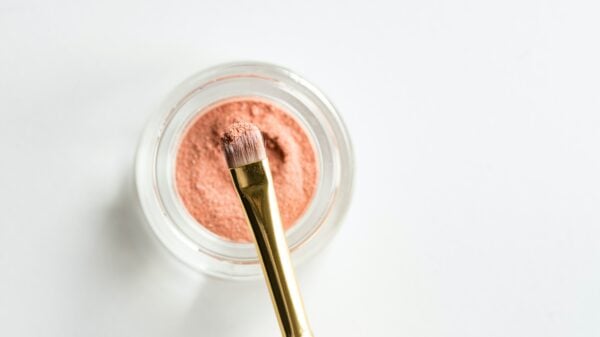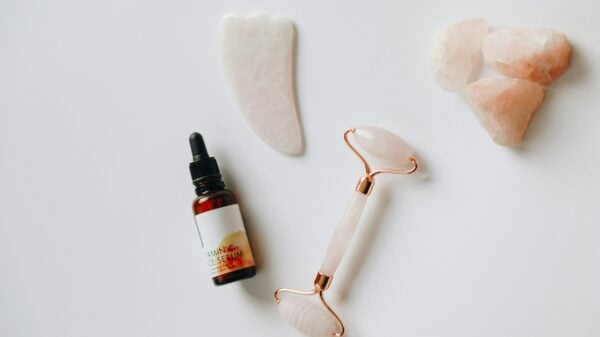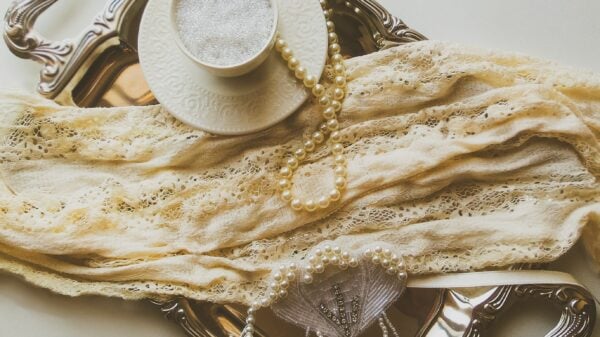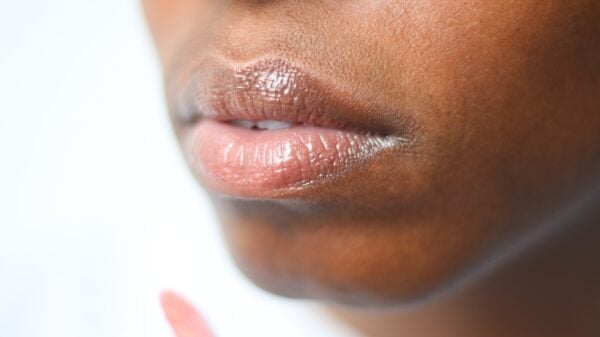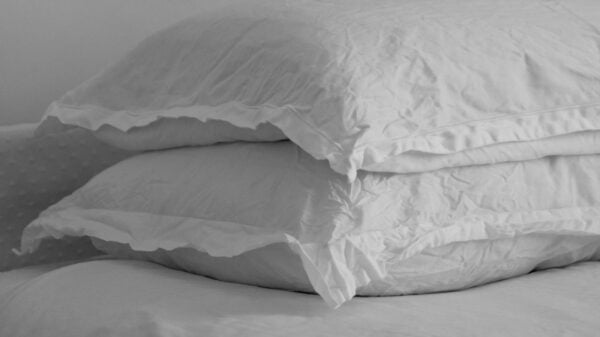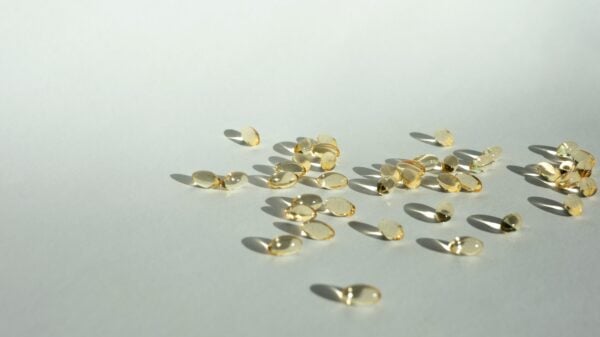Finding the perfect pillow can be a puzzling task, especially with so many filling options to choose from. Did you know that the materials inside your pillow can impact everything from neck support to allergy management? This article will dive into memory foam and feather fillings, guiding you through their comforts, supports, and potential drawbacks to help inform your decision.
Discover the key to waking up refreshed!
Memory Foam Pillow
Memory foam pillows are made from synthetic polyurethane materials and provide customizable shapes for maximum neck pain relief. They also come with gel options and have a fascinating history in the mattress industry.
Description
Memory foam pillows mold to the shape of your head and neck. This gives you support where you need it most. They are made from a material called viscoelastic, which is soft and absorbs movement.
If you move around a lot while sleeping, memory foam can help keep things quiet.
Feather pillows have a different feel. They use feathers from ducks or geese to make a soft and fluffy cushion for your head. These pillows can be very soft and give that feeling of luxury when you go to bed.
They might not hold their shape as well as memory foam does, but they can be fluffed back up easily by shaking them.
Both types come with pros and cons depending on whether you want firmness, softness, or something in between for your sleep comfort needs.
Technical Data
When considering the technical data of memory foam pillows, it’s important to note that they are made from polyurethane with added chemicals to increase density. They are known for their ability to contour to the body, providing excellent support and pressure relief.
Memory foam pillows have a density ranging from 3 to 5 pounds per cubic foot, and the indentation load deflection (ILD) determines its firmness. These pillows are durable and resistant to dust mites, making them suitable for individuals with allergies.
Feather pillows, on the other hand, have a different set of technical data. They are filled with natural bird feathers, predominantly goose or duck feathers. The fill power measures the fluffiness of feather pillows; higher fill power indicates better quality and durability.
Custom Pillow Shapes
Memory foam pillows can be customized into different shapes, providing personalized support for your neck and head. This feature allows you to find the perfect fit for your sleeping position and comfort preferences, promoting a better night’s sleep.
Whether you need a contour pillow or an unconventional shape, memory foam can be molded to suit your specific needs.
Feather pillows, on the other hand, are less customizable in terms of shape. While they offer softness and flexibility, their ability to conform to unique sleeping positions may be limited compared to memory foam pillows.
Company
Memory foam pillows are popular for their comfort and support. When looking at company options, consider those specializing in natural latex products for quality and sustainability.
Check for a wide range of pillow filling options to find the right balance of softness and support. Consider companies that offer customization for different sleeping preferences, including neck pain relief and allergy considerations.
Feather pillows have their own benefits, so look for companies offering high-quality feathers sourced ethically or sustainably. You’ll also want options with good maintenance advice to keep your feather pillows clean and fluffy.
Products
Memory Foam Pillows are designed to provide support and comfort for a good night’s sleep. They come in different shapes, sizes, and firmness levels to suit various preferences. Some memory foam pillows even have cooling gel infused into them to regulate temperature and prevent overheating during the night.
On the other hand, Feather Pillows offer a luxurious feel with their softness and natural material. They are lightweight and moldable, providing a traditional yet sumptuous option for those who prefer a softer pillow.
Now let’s delve into the specifics of Memory Foam Pillows – from technical data to hazards associated with them.
Hazards
When considering the hazards of memory foam pillows, it’s important to note that some people find them too firm and dense, causing discomfort or stiffness. Additionally, memory foam may trap body heat, leading to potential overheating during sleep.
Another hazard is off-gassing from certain memory foam materials, which can produce an unpleasant odor and potentially cause respiratory irritation, especially for those with sensitivities or allergies.
Shifting focus from products to hazards when it comes to feather pillows reveals potential issues such as allergic reactions in individuals sensitive to feathers or down. Furthermore, feathers have been known to poke through pillow covers, causing discomfort.
Memory Foam Pillow History
Memory foam pillows have an interesting history. Initially developed by NASA in the 1970s for airplane seats, memory foam was later introduced into the bedding market due to its pressure-relieving properties.
imemory foam products such as mattresses and pillows that are now available on the market.
Feather pillows have a long history dating back centuries. They were traditionally associated with luxury and comfort among royalty and nobility. Over time, advances in production techniques have made feather pillows more accessible to everyone while still retaining their reputation for providing softness and support.
Memory Foam Pillow Gel
Gel-infused memory foam pillows are designed to offer a cooler and more comfortable sleep experience. The cooling gel helps regulate body temperature, reducing heat retention for a more restful night’s sleep.
This type of pillow is especially beneficial for those who tend to get hot during the night or live in warmer climates, providing an added layer of comfort and support. Gel-infused memory foam pillows also provide the same benefits as traditional memory foam, such as contouring support and pressure relief, making them an excellent choice for individuals seeking both cooling properties and ergonomic design in their pillow.
Mattresses
Memory foam mattresses are known for their ability to contour and support the body, providing relief from pressure points. These mattresses are made from viscoelastic material that responds to body heat and weight, which can help alleviate neck pain and provide a comfortable sleeping surface.
Memory foam also absorbs movement, making it an ideal choice for those who share a bed with restless sleepers or pets. The durability and comfort of memory foam mattresses make them a popular choice for individuals seeking a good night’s rest.
Feather-filled mattresses, on the other hand, offer natural softness and breathability. They provide excellent insulation in colder climates while remaining cool in warmer temperatures.
Feather mattresses can be adjusted by fluffing or compacting them to achieve personal comfort levels. With proper maintenance, feather-filled mattresses can last for years while maintaining their shape and support.
Feather Pillow
Feather pillows come in various types of feathers and offer benefits such as natural softness and support. They require regular maintenance but are a good alternative to memory foam pillows for those seeking a more traditional filling.
Types of Feathers
Feather pillows typically contain either duck or goose feathers. Duck feathers are smaller, creating a softer pillow, while goose feathers are larger and provide firmer support. Some feather pillows also use a combination of both to achieve a balance between softness and firmness.
The most common types of feathers used in these pillows are the outer wing feathers and down — the soft undercoat located beneath the tougher exterior feathers.
Due to their different properties, understanding the types of feathers can help you choose a pillow that suits your preferences for comfort and support. When comparing feather pillows with memory foam, it’s essential to consider these variations in filling materials to determine which option best meets your sleeping needs.
Feather Pillow Benefits
Memory foam pillows offer firm support, which can help alleviate neck pain and provide better spinal alignment. The material molds to the shape of your head and neck, providing a customized sleeping experience.
On the other hand, feather pillows provide a soft and fluffy feel, offering a cozy surface for sleep. They also allow for more airflow compared to memory foam, making them suitable for those who tend to sleep hot.
Depending on your preference for firmness or softness, both pillow types have their own unique benefits that cater to different sleep needs.
Maintenance
To maintain your memory foam pillow, regularly fluff and air it out to keep its shape. Spot clean with a mild detergent if needed, and avoid putting the entire pillow in the washer.
For feather pillows, shake them daily to distribute the feathers evenly, and use a protective cover to prevent dust mites and stains. Machine-wash feather pillows occasionally with mild detergent on a gentle cycle and dry thoroughly to prevent mold growth.
Regular maintenance helps prolong the lifespan of both memory foam and feather pillows while ensuring you have comfortable and supportive sleep.
Comparison with Memory Foam
Feather pillows are softer and lighter than memory foam ones, providing a more traditional sleeping experience. Memory foam pillows offer better support and pressure relief for neck pain, making them ideal for those seeking firmer cushioning.
Feather pillows can feel luxurious but may require frequent fluffing to maintain their shape, while memory foam keeps its form without needing adjustment. Both pillow types have pros and cons based on personal preferences, sleep positions, allergies, and desired comfort level.
Now let’s dive into “How to Choose the Right Pillow Filling” to find the best option that suits your sleeping needs and preferences.
How to Choose the Right Pillow Filling
When choosing the right pillow filling, consider your sleeping position and any allergies you have. Memory foam pillows provide firm support for back and side sleepers, while feather pillows offer a softer feel and better comfort for stomach sleepers.
If you have allergies, opt for hypoallergenic memory foam or synthetic feather alternatives. Natural materials like feathers are more breathable, but require regular fluffing to maintain their shape, whereas memory foam retains its shape without needing much maintenance.
Consider the durability of the pillow filling too – memory foam tends to last longer than feather pillows. Finally, think about the level of softness and support you need for your neck.







